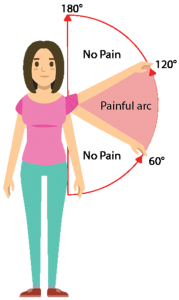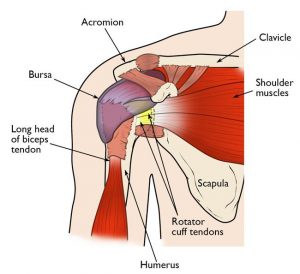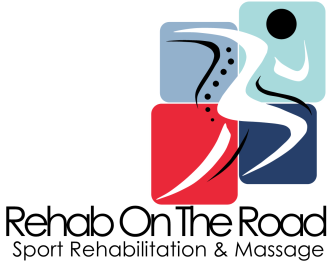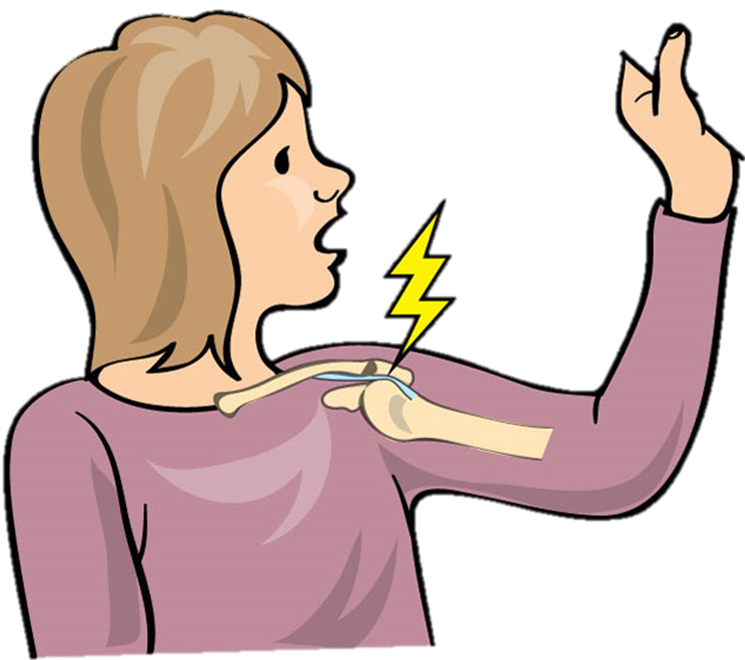Impingement of the shoulder, which is sometimes called swimmer’s shoulder or thrower’s shoulder, is caused by the tendons of the rotator cuff muscles becoming trapped or impinged as they pass through a narrow bony channel.
This channel is called the subacromial space and so-called because it is under the arch of the acromion.With repetitive pinching, the tendons become irritated and inflamed.
This can lead to thickening of the tendon which may cause further problems because there is even less free space.
This is a viscous circle where the tendons become larger, they are impinged further by the structures of the shoulder joint and the muscles themselves
Symptoms
- Shoulder pain with develops gradually over a period of days or weeks.
- Symptoms are worse during overhead movements such as in throwing, racket sports, and swimming.
- Pain may be located to the front and outside of your shoulder joint.
- In particular you will have pain over a 60 degree arc when lifting your arms out sideways and above your head.

Causes
Impingement Syndrome in itself is not a diagnosis, it is a clinical sign. There are at least nine different diagnoses which can cause impingement syndrome.
Bone Spurs . Rotator Cuff Injury . Labral Injury . Shoulder Instability. Biceps Tendinopathy . Scapula Dysfunction
It is thought shoulder impingement begins as an overuse injury of the supraspinatus tendon which runs along the top of the shoulder blade.
Pain then prevents the rotator cuff muscles from working properly which causes the upper arm bone to shift slightly. This may also result in inflammation of the bursa.
Anatomy
Shoulder impingement is classified as internal or external depending on the causes: External shoulder impingement is classified as primary or secondary.
Primary external impingement – is usually due to bony abnormalities in the shape of the acromial arch in the shoulder joint. It can sometimes be due to congenital abnormalities or due to degenerative changes.
Secondary external impingement – is usually due to poor scapular or shoulder blade stabilization which alters the physical position of the acromion, hence causing impingement on the tendons. Is often due to a weak serratus anterior muscle and a tight pectoralis minor muscles.
Internal impingement – This occurs predominantly in athletes where throwing is the main part of the sport, the underside of the rotator cuff tendons impinges against the glenoid labrum.

Treatment
The aim of a shoulder impingement syndrome rehab program is to reduce pain and inflammation, improve or maintain mobility of the shoulder, strengthen any weak muscles and correct postural problems before returning to full fitness. As your symptoms improve, strengthening exercises can begin but within the limits of pain.
Corticosteroid injection are the the option of directly injected steroids into the subacromial space to reduce inflammation and reduce inflammation in the local area although this is not usually an early option. It is usually recommended after a period of at least 6-12 months.
Shoulder impingements are common in individuals with poor posture and scapula movement dysfunctions. This is often caused by tightnesses in the chest muscles, which pull the scapula forward. Also, weakness in the upper back muscles, particularly serratus anterior, which allows the shoulder blade to be pulled forward by the chest muscles.
Working on improving the posture can begin from day one, through demonstrations of good posture and chest stretching. This can be progressed to include scapula setting and stabilisation exercises.
Contact Me
Let's chat!
Need more information? Send me an email or drop me a line. I don’t bite!
- Charlotte@rehabontheroad.co.uk
- 07971448719

